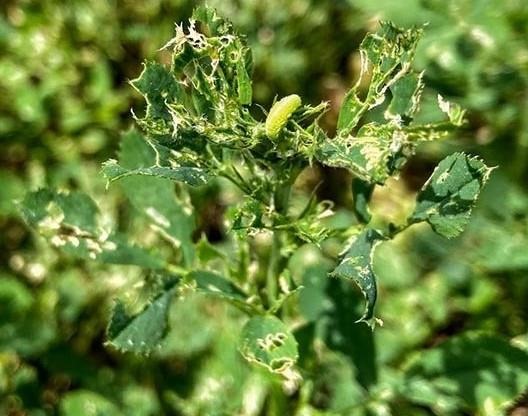By John Tooker
Among the earliest pests to consider each spring is alfalfa weevil. In southern part of Pennsylvania, there has been enough warmth that we should expect alfalfa weevil larvae to be feeding, particularly on warmer, south-facing slopes. Of course, this pest species will become active in the rest of the commonwealth in coming weeks. Alfalfa weevil larvae are easy to identify because they are lime green with a distinct white line down their back (Figure 1), and as young larvae cause pin hole-sized damage to leaves near the tips of plants, often on unfolded leaves. Older larvae consume leaves that are more open, typically leaving jagged edges (Figure 2). Much of this early season feeding does not result in economic loss, but it is good to recognize the damage and be aware of which fields have greater activity. Those fields with larger populations will, of course, be where economically significant populations are more likely to develop, but keep in mind that most fields will not require an insecticide application for this pest species and you should scout to quantify your own populations, rather than just spraying blindly. Blindly spraying for alfalfa weevil larvae will reduce natural enemy populations and render your fields more vulnerable to pests, like potato leafhopper or aphids, later in the season. Economic thresholds for alfalfa weevil are determined from the size of plants, the value of the hay, the cost of insecticidal treatment, and the number of larvae you find per 30 stems of alfalfa. These factors are organized in a decision-making table that is available in our fact sheet linked below. To sample weevil larvae, systematically select 30 stems from across a field and shake them into a bucket. If the number of larvae exceeds the threshold, a treatment might be warranted. See our recently revised fact sheet for thresholds and more details on alfalfa weevil biology . Happy scouting and I hope you do not find any!

Figure 2. Damage from older alfalfa weevil larvae (Photo by Adriana Murillo-Williams, Penn State Extension)
Source : psu.edu